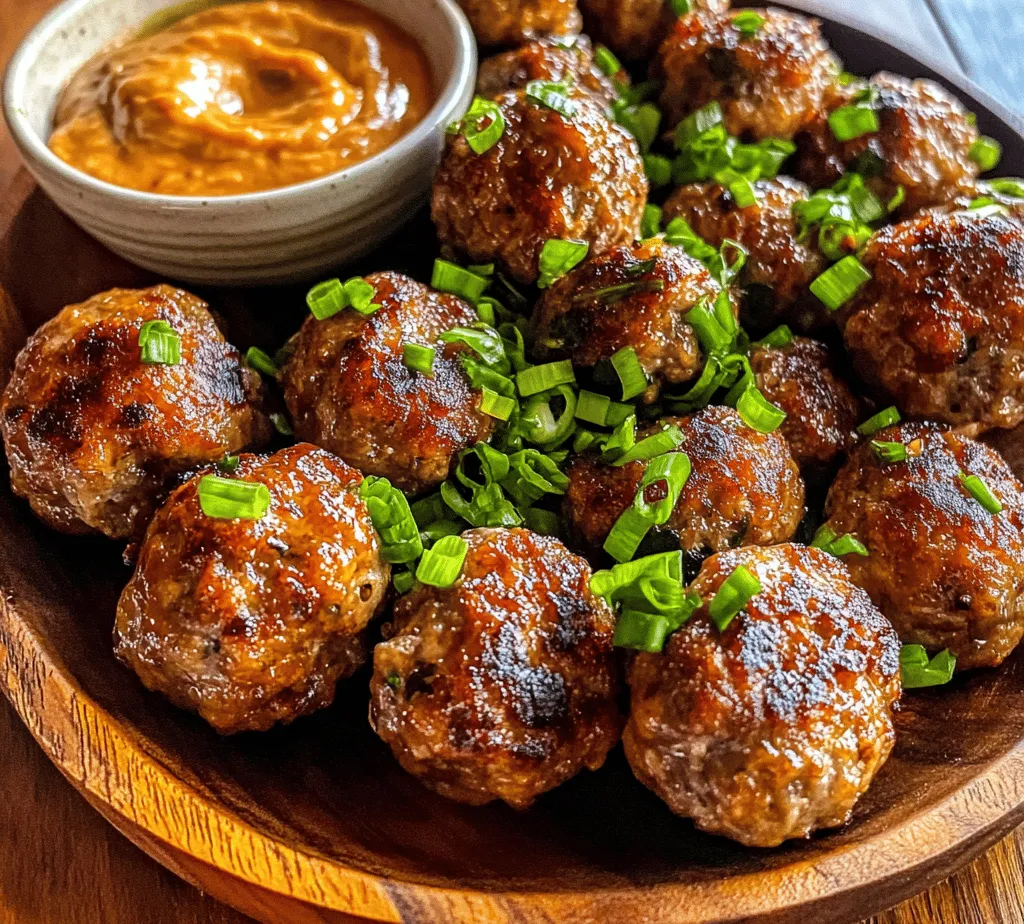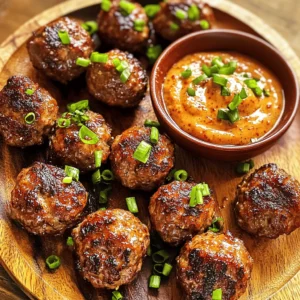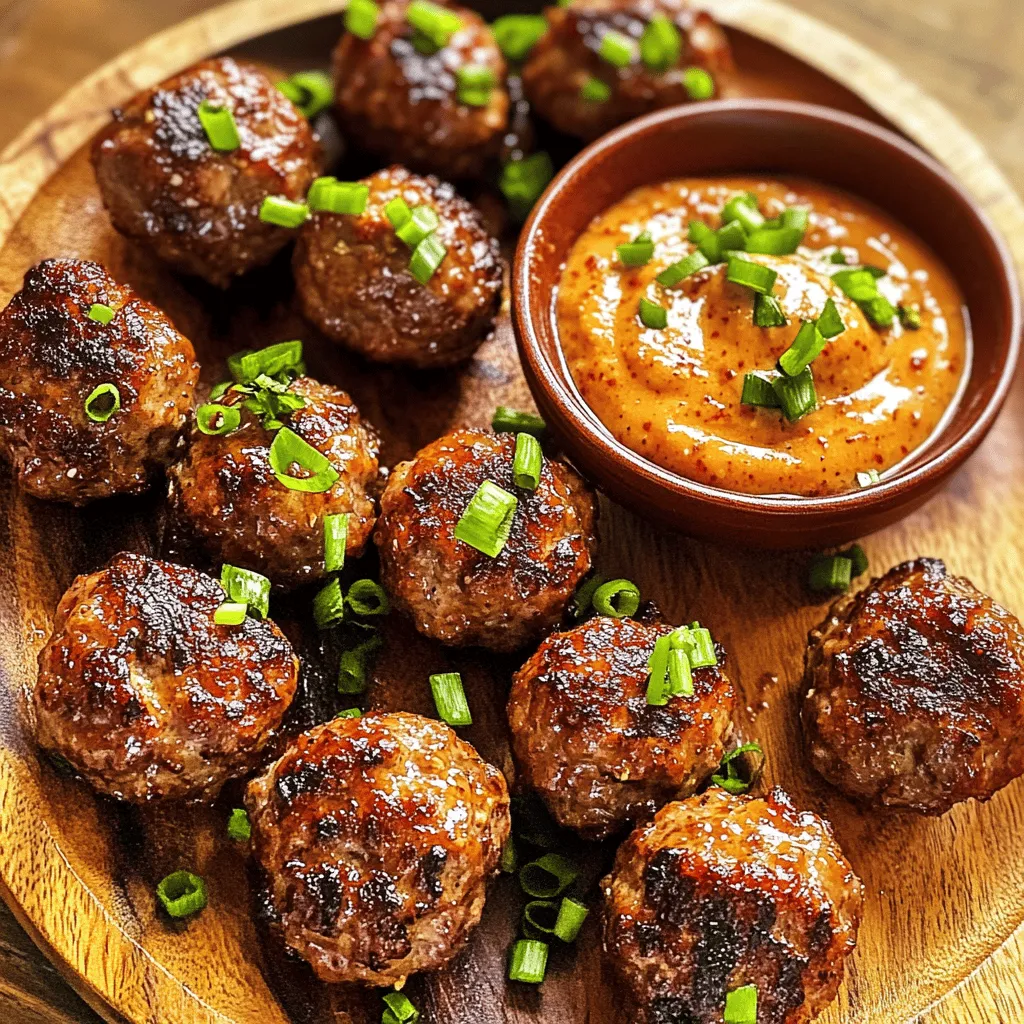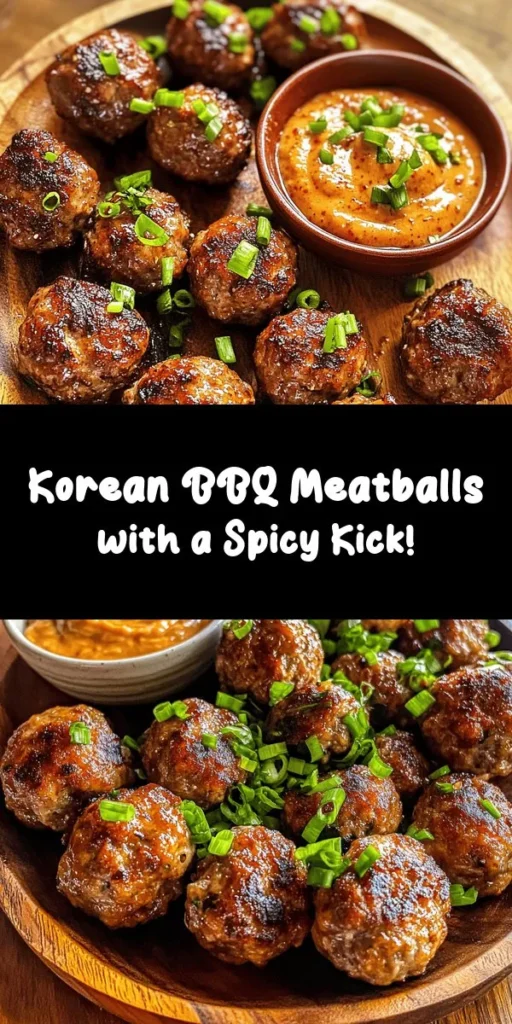Introduction
Korean cuisine has taken the culinary world by storm, celebrated for its bold flavors, vibrant colors, and the delightful interplay of textures. This unique food culture has captivated food enthusiasts globally, bringing traditional dishes and contemporary interpretations to the forefront. Among the many culinary gems that represent the essence of Korean cooking, Korean BBQ meatballs stand out as an exceptional fusion dish. Combining the beloved elements of Korean barbecue with the comfort and familiarity of meatballs, this recipe offers an irresistible blend of savory, sweet, and spicy flavors.
Korean BBQ meatballs are not just your average meatballs; they are packed with a distinctive flavor profile that can elevate any meal. Whether served as an appetizer, a main dish, or even as part of a festive spread, these meatballs bring versatility to the table. Their juicy, tender texture paired with a sweet and spicy glaze makes them a hit at gatherings, parties, and family dinners alike. And no Korean BBQ meatball experience would be complete without the perfect dipping companion: a creamy, spicy mayo dip that enhances the dish’s overall appeal.
In this article, we will explore the delicious world of Korean BBQ meatballs, guiding you step-by-step through the preparation process while highlighting the key ingredients that make this dish a standout. From understanding the nutritional benefits of the ingredients to crafting the ideal spicy mayo dip, we will ensure you have all the tools necessary to create a delightful culinary experience.
Understanding the Ingredients
To create the perfect Korean BBQ meatballs, it is essential to understand the key ingredients that contribute to their unique flavor and texture. Each component plays a vital role in crafting this delightful dish, from the meats used to the spices that elevate the overall profile.
Ground Beef and Pork
A combination of ground beef and pork serves as the base for these meatballs, providing a rich and savory flavor. Ground beef adds a hearty, meaty taste, while ground pork introduces a slight sweetness and moisture, resulting in tender meatballs. Both meats are excellent sources of protein, iron, and essential vitamins, making them a nutritious choice for any meal. The blend of these two proteins creates a well-rounded flavor that is both satisfying and delicious.
Breadcrumbs
Breadcrumbs are an essential ingredient in meatball recipes, acting as a binding agent that helps hold the mixture together while also contributing to the texture. They add a lightness to the meatballs, ensuring that they are not dense or heavy. In this recipe, using plain or panko breadcrumbs can enhance the meatballs’ overall structure and allow them to cook evenly, resulting in a delightful bite every time.
Ginger and Garlic
No Korean dish is complete without the aromatic flavors of ginger and garlic. These two ingredients are staples in Korean cooking, adding depth and complexity to the meatball mixture. Ginger contributes a slightly spicy and warm flavor, while garlic provides a robust, savory note. Additionally, both ingredients are known for their numerous health benefits, including anti-inflammatory properties and potential immune-boosting effects.
Green Onions
Green onions, also known as scallions, are a fantastic way to add freshness and crunch to Korean BBQ meatballs. They not only enhance the flavor profile but also add a pop of color to the dish. Rich in vitamins A, C, and K, green onions offer a range of health benefits, including improved digestion and cardiovascular health. Their mild, onion-like flavor complements the richness of the meat while providing a contrast in texture.
Soy Sauce and Sesame Oil
Soy sauce is a quintessential ingredient in Korean cuisine, lending a salty umami flavor to the meatball mixture. It enhances the overall taste while providing moisture, ensuring the meatballs remain juicy during cooking. Sesame oil, on the other hand, adds a toasted, nutty flavor that is characteristic of many Korean dishes. This combination of soy sauce and sesame oil is what truly brings an authentic Korean essence to the meatballs.
Gochugaru
The spice element in this recipe comes from gochugaru, a Korean red pepper powder known for its vibrant red color and mild to moderate heat. Gochugaru not only adds spice but also contributes a subtle sweetness and smokiness that elevates the flavor of the meatballs. It is a key ingredient in many Korean dishes, making it essential for achieving that authentic taste.
Honey
To balance the savory and spicy flavors, honey is incorporated into the meatball mixture. Its natural sweetness helps to round out the taste, creating a harmonious blend of flavors. Additionally, honey adds moisture, ensuring the meatballs remain tender and juicy. This touch of sweetness is a hallmark of Korean BBQ, making it an important element in this recipe.
Spicy Mayo Dip Ingredients
The accompanying spicy mayo dip is an essential component that enhances the Korean BBQ meatball experience. A few key ingredients come together to create a creamy, spicy, and tangy dip that perfectly complements the meatballs.
Mayonnaise
As the base of the spicy mayo dip, mayonnaise provides a creamy texture that coats the meatballs beautifully. It serves as a neutral canvas that allows the other flavors to shine through. Additionally, mayonnaise adds richness to the dip, making it a delightful counterpart to the savory meatballs.
Sriracha
For those who enjoy a little heat, Sriracha is the go-to ingredient for the spicy mayo dip. This chili sauce delivers a punch of flavor with its distinctive blend of garlic and vinegar, allowing you to customize the spice level to your preference. Adjusting the amount of Sriracha can create varying degrees of heat, making this dip versatile for all palates.
Lemon Juice
To balance the richness of the mayonnaise and the heat of the Sriracha, a splash of lemon juice is added to the dip. The acidity of the lemon brightens the flavors, providing a refreshing contrast that elevates the overall taste of the dip. Lemon juice also enhances the dip’s acidity, making it a well-rounded complement to the meatballs.
Optional Enhancements
For those looking to take their spicy mayo dip to the next level, there are a few optional enhancements. Adding a drizzle of honey can provide extra sweetness, harmonizing the flavors even further. Chopped green onions can be sprinkled on top of the dip for added freshness and a pop of color, making it as visually appealing as it is delicious.
Step-by-Step Preparation of Korean BBQ Meatballs
Now that we have a solid understanding of the key ingredients, it’s time to dive into the preparation of the delicious Korean BBQ meatballs. Follow these step-by-step instructions to create mouthwatering meatballs that will impress your family and friends.
Step 1: Preheat the Oven
Start by preheating your oven to 400°F (200°C). This temperature is ideal for cooking meatballs, allowing them to develop a nice golden-brown crust on the outside while remaining juicy on the inside. Preheating the oven ensures that the meatballs cook evenly, creating a delightful texture.
Step 2: Prepare the Baking Sheet
While the oven is heating up, prepare a baking sheet by lining it with parchment paper. This will prevent the meatballs from sticking to the sheet and make for easy cleanup. If you don’t have parchment paper, you can lightly grease the baking sheet with cooking spray or oil to achieve the same effect.
Step 3: Mix the Meatball Ingredients
In a large mixing bowl, combine the ground beef and pork, breadcrumbs, minced ginger, minced garlic, chopped green onions, soy sauce, sesame oil, gochugaru, and honey. Using your hands, gently mix the ingredients together until they are well combined. Be careful not to overmix, as this can lead to tough meatballs. The key is to incorporate all the ingredients evenly while maintaining a tender texture.
As you mix, take a moment to appreciate the wonderful aroma of the ginger and garlic wafting through the air. The combination of savory, sweet, and spicy notes will entice your taste buds and set the stage for a delicious meal.
Step 4: Form the Meatballs
Once the meatball mixture is well combined, use your hands to shape the mixture into meatballs, about 1 to 1.5 inches in diameter. Place the formed meatballs onto the prepared baking sheet, ensuring they are spaced evenly apart. This allows them to cook uniformly and prevents them from sticking together.
With this organized approach, you’ll have a beautiful batch of meatballs ready for the oven, each one bursting with flavor and promising a delightful eating experience.
In the next part of this article, we will cover the cooking process for the meatballs and how to prepare the spicy mayo dip to serve alongside. Stay tuned for an exciting culinary journey that will transform your kitchen into a Korean barbecue haven!

Importance of Thorough Mixing for Flavor Distribution
When preparing Korean BBQ meatballs, achieving a well-balanced flavor profile is essential. The key to this lies in the thorough mixing of the ingredients. Combining ground meat with seasonings, breadcrumbs, and aromatics ensures that each meatball is packed with flavor. Start by placing your ground beef or pork in a large mixing bowl and adding the ingredients such as minced garlic, grated ginger, soy sauce, sesame oil, and chopped green onions. Use your hands or a fork to mix the ingredients gently but thoroughly. This process is crucial; not only does it help in flavor distribution, but it also aids in achieving the desired texture, ensuring that the meatballs are tender yet firm enough to hold their shape during cooking.
Tips on Shaping Meatballs for Even Cooking
Shaping the meatballs correctly is equally important for even cooking. Aim for uniformity in size; this ensures that each meatball cooks at the same rate. A good size for Korean BBQ meatballs is about 1.5 inches in diameter. To achieve this, consider using a small ice cream scoop or your hands to form the balls. Lightly wetting your hands can prevent the mixture from sticking, making it easier to shape. When rolling the meatballs, be gentle to avoid compacting the mixture too much, which can lead to dense meatballs. Once shaped, place them on a parchment-lined baking sheet, ensuring they are spaced apart to allow for even heat circulation.
Baking Process: Ideal Temperature and Indicators for Doneness
For the best results, preheat your oven to 400°F (200°C). This temperature is ideal for baking meatballs, allowing them to brown nicely while cooking through evenly. After placing the meatballs in the oven, set a timer for about 18 to 20 minutes. To check for doneness, use a meat thermometer; the internal temperature should reach 160°F (71°C) for ground beef or pork. If you prefer a crispier exterior, you can broil the meatballs for an additional 2-3 minutes at the end of the baking process. Keep a close eye during this step to prevent burning, as broilers can cook food quickly.
Cooking Times and Variations Based on Oven Performance
Cooking times may vary based on your oven’s performance and the size of the meatballs. If your oven runs hot or cool, you may need to adjust the cooking time slightly. It’s always best to check for doneness a few minutes before the timer goes off. Additionally, if you are using a convection oven, the cooking time may be reduced by 2 to 3 minutes due to the circulating hot air. Remember, the goal is to achieve a golden-brown exterior while ensuring the interior remains juicy and flavorful.
Crafting the Spicy Mayo Dip
While the meatballs are baking, you can prepare the spicy mayo dip, which complements the savory flavors of the meatballs beautifully. To make the dip, combine mayonnaise, Sriracha sauce, a splash of rice vinegar, and a dash of sesame oil in a small bowl. Start with a tablespoon of Sriracha and gradually add more according to your spice preference. Mix thoroughly until the ingredients are well blended, and taste to adjust the seasoning. For an extra kick, consider adding a sprinkle of chili flakes or a few drops of hot chili oil.
Suggestions for Presentation and Garnishing the Dip
Presentation can elevate your dish, so consider garnishing the spicy mayo dip with chopped green onions or sesame seeds. Serve it in a small bowl alongside the meatballs, creating a beautiful contrast with the red of the dip against the brown of the meatballs. For an extra touch, drizzle a little sesame oil on top of the dip just before serving. This not only adds flavor but also enhances the visual appeal.
Serving Suggestions and Pairings
Korean BBQ meatballs are versatile and can be served in various ways, making them perfect for appetizers, main courses, or even party snacks. For a fun appetizer, serve the meatballs on skewers, allowing guests to easily grab them. If you want to create a main course, serve the meatballs over a bed of steamed rice or noodles, drizzling the spicy mayo dip on top for added flavor.
For side dishes, consider traditional Korean accompaniments like kimchi, pickled vegetables, or a simple cucumber salad. These sides not only complement the meatballs but also add freshness and balance to the meal. Another creative serving idea is to present the meatballs in lettuce wraps. Provide whole lettuce leaves, allowing guests to wrap the meatballs and enjoy them with a dollop of spicy mayo dip.
Cultural Significance of Korean BBQ
Korean BBQ has a rich history that dates back centuries. Traditionally, it involves grilling various meats at the table, allowing diners to cook their own food to their liking. This communal dining experience emphasizes togetherness and the joy of sharing meals. Korean BBQ has gained popularity worldwide, influencing many culinary trends, including fusion cuisine, where traditional Korean dishes are blended with other global flavors.
Dishes like Korean BBQ meatballs fit seamlessly into this broader context, providing a modern twist on traditional flavors. They are a perfect representation of how Korean cuisine has evolved, making it accessible and appealing to a wider audience. The rise of fusion cuisine reflects a growing interest in diverse culinary experiences, and Korean BBQ meatballs are an excellent example of this trend.
Nutritional Information
When it comes to nutritional value, Korean BBQ meatballs can be a healthier alternative to traditional meatballs. Each serving typically contains around 250-300 calories, depending on the ingredients used and portion size. They are rich in protein from the meat, and the addition of fresh ingredients like green onions and garlic enhances their nutritional profile.
Using lean meats, such as ground turkey or chicken, can further reduce the calorie count while still providing a satisfying meal. The use of flavorful seasonings means you can enjoy a dish that is both tasty and nutritious. Compared to traditional meatball recipes, which often rely on heavy sauces or additional fats, Korean BBQ meatballs offer a lighter option without sacrificing flavor.
Conclusion
Korean BBQ meatballs paired with spicy mayo dip present a delightful culinary experience that brings together unique flavors and textures. The combination of savory meatballs with a zesty, creamy dip creates a dish that is sure to impress your family and friends. Cooking this dish at home allows you to explore the rich world of Korean flavors and enjoy the satisfaction of creating something delicious from scratch.
As you embark on this culinary journey, don’t hesitate to experiment with variations, such as different proteins, spice levels, or additional ingredients. The beauty of cooking lies in the ability to adapt and personalize recipes to suit your taste. Embrace the joy of Korean cuisine, and savor every delicious bite of your homemade Korean BBQ meatballs.



